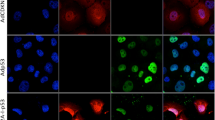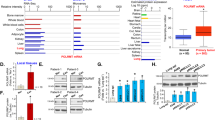Abstract
The TSLC1 tumor-suppressor gene is silenced in a number of human cancer tissues and cell lines, including lung, prostate, liver, stomach, pancreatic, and breast cancers. Expression of TSLC1 in a non-small-cell lung cancer (NSCLC) cell line A549 suppresses tumorigenicity in nude mice. However, the molecular mechanism of TSLC1 action is not yet elucidated. In the present study, we show that the expression of TSLC1 from a recombinant adenovirus vector (Ad-TSLC1) inhibited cell proliferation and induced apoptosis in the NSCLC cell line A549. We also demonstrated that subcutaneous tumor growth in nude mice induced by A549 cells was suppressed to the extent of 70–80% by intratumoral injection of Ad-TSLC1. Re-expression of TSLC1 also resulted in activation of the apoptotic protease caspase-3, accompanied by the cleavage of its substrate poly (ADP-ribose) polymerase (PARP). The antiproliferative and pro-apoptotic activity of TSLC1 required the presence of the FERM-binding and PDZ-interacting motifs located in the cytoplasmic domain. Our results demonstrate the pro-apoptotic and oncosuppressive activity of TSLC1 protein, and suggest the potential of TSLC1 for gene therapy.









Similar content being viewed by others
References
Allinen M, Peri L, Kujala S, Lahti-Domenici J, Outila K, Karppinen SM, Launonen V and Winqvist R . (2002). Genes Chromosomes Cancer, 34, 384–389.
Ashe PC and Berry MD . (2003). Biol. Psychiatry, 27, 199–214.
Aznar S and Lacal JC . (2001). Cancer Lett., 165, 1–10.
Fukami F, Fukuhara H, Kuramochi M, Maruyama T, Isogai K, Sakamoto M, Takamoto S and Murakami Y . (2003). Int. J. Cancer, 107, 53–59.
Fujita E, Soyama A and Momoi T . (2003). Exp. Cell Res., 287, 57–66.
Fukuhara H, Kuramochi M, Fukami T, Kasahara K, Furuhata M, Nobukuni T, Maruyama T, Isogai K, Sekiya T, Shuin T, Kitamura T, Reeves RH and Murakami Y . (2002). Jpn. J. Cancer Res., 93, 605–609.
Fukuhara H, Masuda M, Yageta M, Fukami T, Kuramochi M, Maruyama T, Kitamura T and Murakami Y . (2003). Oncogene, 22, 6160–6165.
Hall A . (1998). Science, 279, 509–514.
Harris BZ and Lim WA . (2001). J. Cell Sci., 114, 3219–3231.
Honda T, Tamura G, Waki T, Jin Z, Sato K, Motoyama T, Kawata S, Kimura W, Nishizuka S and Murakami Y . (2002). Jpn. J. Cancer Res., 93, 857–860.
Hoover KB and Bryant PJ . (2000). Curr. Opin. Cell Biol., 12, 229–234.
Ito A, Okada M, Uchino K, Wakayama T, Koma Y, Iseki S, Tsubota N, Okita Y and Kitamura Y . (2003). Lab. Invest., 87, 1175–1183.
Jansen M, Fukushima N, Rosty C, Walter K, Altink R, Heek TV, Hruban R, Offerhaus JG and Goggins M . (2002). Cancer Biol. Ther., 1, 293–296.
Ji L, Fang B, Yen N, Fong K, Minna JD and Roth JA . (1999). Cancer Res., 59, 3333–3339.
Katsuda K, Kataoka M, Uno F, Murakami T, Kondo T, Roth JA, Tanaka N and Fujiwara T . (2002). Oncogene, 21, 2108–2113.
Kuramochi M, Fukuhara H, Nokubuni T, Kanbe T, Maruyama T, Ghosh HP, Pletcher M, Isomura M, Onizuka M, Kitamura T, Sekiya T, Reeves RH and Murakami Y . (2001). Nat. Genet., 27, 427–430.
Mao X, Seidlitz E, Ghosh K, Murakami Y and Ghosh HP . (2003). Cancer Res., 63, 7979–7985.
Marfatia SM, Leu RA, Branton D and Chishti AH . (1995). J. Biol. Chem., 270, 715–719.
Marfatia SM, Morais-Cabral JH, Kim AC, Byron O and Chishti AH . (1997). J. Biol. Chem., 272, 24191–24197.
Masuda M, Yageta M, Fukuhara H, Kuramochi M, Maruyama T, Nomoto A and Murakami Y . (2002). J. Biol. Chem., 277, 31014–31019.
Murakami Y, Nobukuni T, Tamura K, Maruyama T, Sekiya T, Arai Y, Gomyou H, Tanigami A, Ohki M, Cabin D, Frischmeyer P, Hunt P and Reeves RH . (1998). Proc. Natl. Acad. Sci. USA, 95, 8153–8156.
Ng P and Graham FL . (2002). Methods Mol. Med., 69, 389–414.
Roz L, Gramegna M, Ishii H, Croce CM and Sozzi G . (2002). Proc. Natl. Acad. Sci. USA, 99, 3615–3620.
Saeki T, Mhashilkar A, Chada S, Branch C, Roth JA and Ramesh R . (2000). Gene Therapy, 7, 2051–2057.
Saeki T, Mhashilkar A, Swanson X, Zou-Yang XH, Sieger K, Kawabe S, Branch CD, Zumstein L, Meyn RE, Roth JA, Chada S and Ramesh R . (2002). Oncogene, 21, 4558–4566.
Sheng M and Sala C . (2001). Annu. Rev. Neurosci., 24, 1–29.
Smith SA, Holik P, Stevens J, Mazoyer S, Melis R, Williams B, White R and Albertsen H . (1996). Genomics, 31, 145–150.
Tran YK, Bogler O, Gorse KM, Wieland I, Green MR and Newsham IF . (1999). Cancer Res., 59, 35–43.
Uchino K, Ito A, Wakayama T, Koma Y, Okada T, Ohbayashi C, Iseki S, Kitamura Y, Tsubota N, Okita Y and Okada M . (2003). Cancer, 98, 1002–1007.
Yageta M, Masami K, Masuda M, Fukami T, Fukuhara H, Maruyama T, Shibuya M and Murakami Y . (2002). Cancer Res., 62, 5129–5133.
Acknowledgements
We thank G Singh, J Hassell, DW Andrews, M Annis, J Knez, N McFarlaine, and J Rudy for their help and J Paul for manuscript preparation. This study was supported by the National Cancer Institute of Canada.
Author information
Authors and Affiliations
Corresponding author
Rights and permissions
About this article
Cite this article
Mao, X., Seidlitz, E., Truant, R. et al. Re-expression of TSLC1 in a non-small-cell lung cancer cell line induces apoptosis and inhibits tumor growth. Oncogene 23, 5632–5642 (2004). https://doi.org/10.1038/sj.onc.1207756
Received:
Revised:
Accepted:
Published:
Issue Date:
DOI: https://doi.org/10.1038/sj.onc.1207756
- Springer Nature Limited
Keywords
This article is cited by
-
Microcystis aeruginosa mediated biofabrication of silver nanoparticles exhibiting antibacterial, antioxidant, anticancer, and azo dye degrading catalytic activities
Biomass Conversion and Biorefinery (2023)
-
The identification of induction chemo-sensitivity genes of laryngeal squamous cell carcinoma and their clinical utilization
European Archives of Oto-Rhino-Laryngology (2018)
-
Tumor suppressor role of protein 4.1B/DAL-1
Cellular and Molecular Life Sciences (2014)
-
Tumor suppressor in lung cancer-1 (TSLC1) mediated by dual-regulated oncolytic adenovirus exerts specific antitumor actions in a mouse model
Acta Pharmacologica Sinica (2013)
-
Tumor suppressor in lung cancer 1 (TSLC1), a novel tumor suppressor gene, is implicated in the regulation of proliferation, invasion, cell cycle, apoptosis, and tumorigenicity in cutaneous squamous cell carcinoma
Tumor Biology (2013)




